 Regional guide, 12 Oct 1951. |
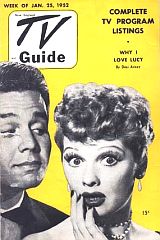 Regional guide, 25 Jan 1952. |
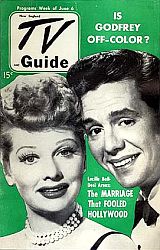 Regional guide, 6 June 1952. |
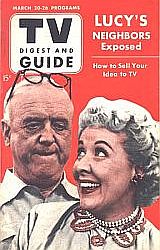 Regional guide, 20 March 1953. |
 Nat’l TV Guide - 3 April 1953. |
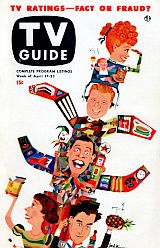 Week of April 17th,1953. |
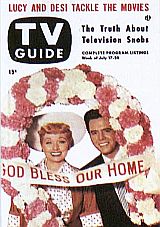 Week of July 17, 1953. |
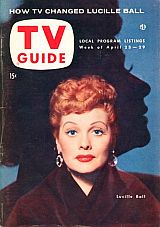 Week of April 23rd, 1954. |
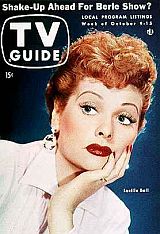 Week of October 9th, 1954. |
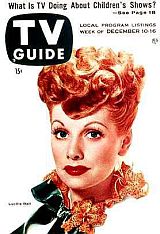 Week of December 10th, 1955. |
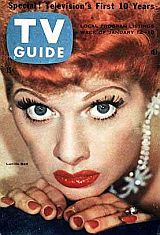 Week of January 12th, 1957. |
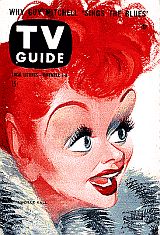 Week of November 2nd, 1957. |
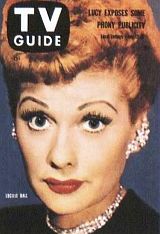 Week of July 12th, 1958. |
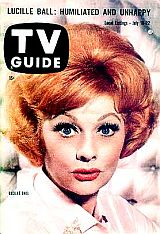 Week of July 16th, 1960. |
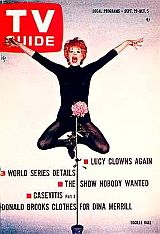 Week of September 29th, 1962. |
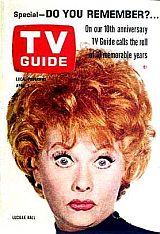 Week of April 6th, 1963. |
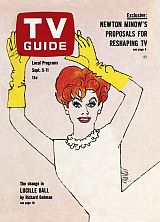 Week of September 5th, 1964. |
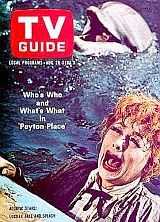 Week of August 28th, 1965. |
For more than 60 years, Lucille Ball’s famous television character “Lucy” – the red-headed star of the iconic 1950s I Love Lucy sitcom – helped enrich a part of the publishing world that covered television. And no publication in that arena benefited more from Lucy than TV Guide. It all began in the early 1950s, as the I Love Lucy show took off and swept the nation.
By April 1952, more than 10 million households were tuning in to I Love Lucy, the first time in history that a television show had reached that many people. By October 1952 it was the No. 1 TV show in America, scoring an incredible 67.3 rating, meaning that two-thirds of all homes with TV sets were tuned to Lucy. The show proceeded to dominate the TV ratings through most of the decade, creating something of a new entertainment phenomenon.
But in the early days of television, program guides for TV watching were rare and fairly basic. And they were not found everywhere. At first – and as early as 1948 – there were a few regional TV channel listings and guides. Some of these guides, appearing in the 1951-1953 period, were among the first to run covers with Lucy, her husband, Desi Arnaz, and other co-stars from the I Love Lucy show.
In Philadelphia, Pennsylvania at that time there was a company named Triangle Publications, established by the Annenberg family. Triangle had initially risen on the success of the Daily Racing Form and a wire service that connected racetracks with bookies. Walter Annenberg, Jr., son of founder Moses Annenberg, was running the Philadelphia Inquirer newspaper when he started thinking about a national TV guide in 1952. Annenberg bought up several of the smaller regional television magazines that had already begun publishing TV listings – among them, TV Digest in Philadelphia, TV Forecast in Chicago, and TV Guide in New York and New England, the latter of which is sampled in the first few slots here, above right.
Then in 1952 and 1953 came the I Love Lucy episodes surrounding the pregnancy of Lucy – in real life and on the show – and the birth of her son in 1953. At first hesitant to use Lucy’s actual pregnancy in the show, Lucy’s baby-to-be soon became a central part of the show’s plot over some weeks, generating a huge following and culminating in the birth episode of January 19, 1953, “Lucy Goes to the Hospital.” Some 44 million viewers watched that episode, then a record audience, easily eclipsing the 20 million or so who watched President Dwight D. Eisenhower’s inauguration.
TV Guide’s first national issue picked up on this Lucy mania, and on April 3, 1953 ran a cover featuring a photograph of Lucille Ball’s newborn son, Desi Arnaz, Jr., along with a top-of-the-page teaser headline, “Lucy’s $50,000,000 Baby.” A small photo of Lucy was also placed in the top corner of that cover.
What TV Guide meant by the “$50,000,000 Baby” line was the fact that Lucy’s TV “mommyhood,” as the magazine put it, “triggered an avalanche of merchandise.” As TV Guide would later explain, that lucrative avalanche included: “dolls, games, books and nursery sets, as well as Lucy maternity wear and Desi smoking jackets…” Replicas of the Ricardos’ bedroom and living-room furniture were also sold. And Desi’s recording, “There’s a Brand New Baby in Our House,” was popular on the music charts. Said TV Guide: “We even suggested Little Desi’s worth might actually be closer to $100 million.”
With TV Guide’s first national edition, using the “Lucy’s baby” cover, a long and profitable relationship began between the weekly magazine and Lucille Ball. Lucy, of course, wasn’t the only star in the TV constellation in those years, and TV Guide would use them all. But in the end, Lucy would garner more TV Guide covers that any other star then or since – at least 44 in which she appeared as the featured star or included with others.
( In the 1950s, Walter Annenberg’s business empire in Philadelphia also included WFIL-TV, where a new TV dance show in the 1950s called American Bandstand was taking hold, which TV Guide would promote as well.)
In April 1953, when it first launched nationally, the weekly circulation of TV Guide’s was about 1.5 million. But it soon climbed upward that fall, and would sell millions more copies for years to come.
By the 1960s, TV Guide was the most read and circulated magazine in the United States. Each issue’s features were also promoted in a weekly television commercial.
By 1974, TV Guide became the first magazine ever to sell 1 billion copies in a year. Among inside jokes then circulating in Annenberg’s Triangle Publications was: “Each week we lose more copies of TV Guide off the backs of our trucks than most other magazines sell.”
TV Guide, like other magazines, was sold at grocery stores, drug stores, and supermarket check-out counters nationwide. Subscriptions were also available. But over the years, typically two-thirds of TV Guide’s sales came from those newsstands. And Lucy and her travails – both on and off screen – would prove especially appealing to newsstand readers over the years. “Lucy covers” no doubt sold well in those years, so she continued to receive top billing in the magazine. Lucy, her family, and the I Love Lucy TV series all became a rich vein for TV Guide cover stories and articles over the next sixty years, from 1953 through 2013.
Under Triangle’s management, TV Guide continued to grow, not only in circulation, but also as a recognized authority on television programming, with engaging articles from staff and outside writers. Lucy stories of every conceivable sort were also among those published.
The July 17th, 1953 edition focused on a movie Lucy and Desi were then making, The Long, Long Trailer. The April 23rd, 1954 issue included the cover story, “How TV Changed Lucille Ball.” The July 30, 1955 TV Guide (not shown), had Lucy and Desi on the cover along with The Whiting Girls, who also had a CBS sitcom.
Subsequent issues of TV Guide simply featured head shots of Lucy with no related story indicated. The December 10th, 1955 cover featured a portrait of Lucy that Desi Arnaz had hung in his Hollywood office. The November 2nd, 1957 issue featured an illustration of Lucy by artist Al Hirschfeld, known for his New Yorker sketches. The July 12th, 1958 issue put Lucy on the cover and also carried a story tagline, “Lucy Exposes Some Phony Publicity.” In July 1960, after Lucy had finalized her divorce with Desi, TV Guide had her on the cover with the story, “Lucille Ball: Humiliated and Unhappy.”“Possibly the most unset- tling event on the current TV scene is the new husbandless Lucy, who is making her debut on The Lucy Show… as a widow with two children. . .”
– TV Guide, Sept 1962
By the fall of 1962, with the launch of Lucille Ball’s new sitcom, “The Lucy Show,” TV Guide put her on the cover of its September 29th issue in a comedic jumping pose with the tagline, “Lucy Clowns Again.” The first few paragraphs of that cover story read as follows:
“Possibly the most unsettling event on the current TV scene is the new husbandless Lucy, who is making her debut on The Lucy Show this Monday as a widow with two children.
“Encountering America’s favorite zany in a new habitat, with a new last name (Carmichael), with unknown children and without her dashing Desi, is an odd experience. A decade of I Love Lucy shows has so indissolubly wedded the images of Lucy and Desi Arnaz that to discover a Desi-less Lucy on the screen is like finding a revised edition of “Gone with The Wind” in which Scarlett O’Hara appears without Rhett Butler.
“Nevertheless, the ‘new’ Lucy, despite the alien corn, is identical to the ‘old’ Lucy – unaltered in all essentials of character and personality… She is still the frantically funny creature she always was, swinging overhand from emotion to emotion, perpetually tossed on the horns of some preposterous dilemma…”
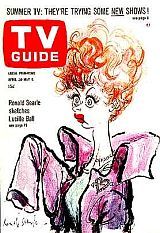 Week of April 30th, 1966. |
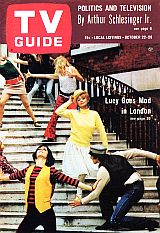 Week of October 22nd, 1966. |
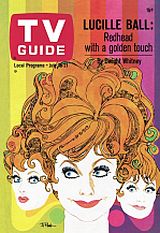 Week of July 15th, 1967. |
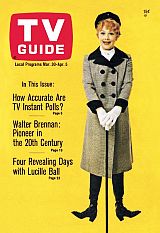 Week of March 30th, 1968. |
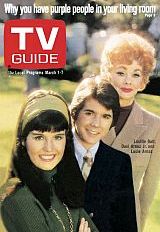 Week of March 1st, 1969. |
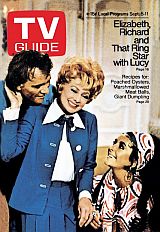 Week of September 5th, 1970. |
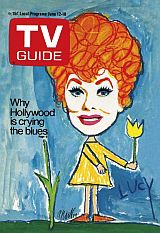 Week of June 12th, 1971. |
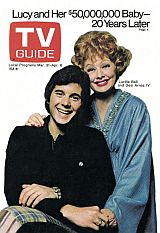 Week of March 31st, 1973. |
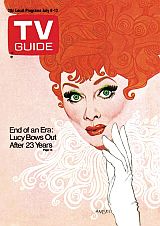 Week of July 6th, 1974. |
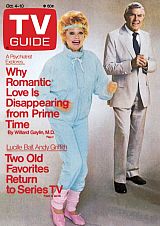 Week of October 4th, 1986. |
 Week of March 12, 1988. |
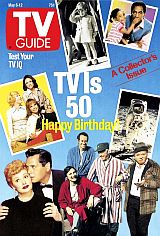 Week of May 6, 1989. |
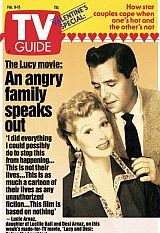 Week of February 9, 1991. |
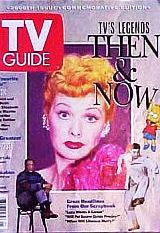 July 1991: 2000th Issue. |
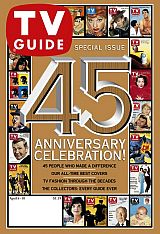 Week of April 4th, 1998. |
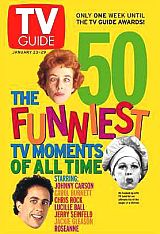 Week of January 23rd, 1999. |
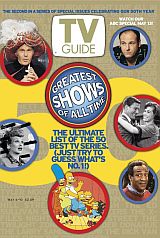 Week of May 4th, 2002. |
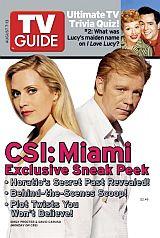 Week of August 7th, 2005. |
In April 1963, for the 10th anniversary issue of TV Guide, Lucille Ball was the featured cover personality, as the magazine asked its readers if they ….subject. For the September 5, 1964 issue of TV Guide, the magazine offered an artist’s rendering of Lucy on the cover with a story titled “The Change in Lucille Ball,” which covered her… That edition also had the cover headline, “Newton Minow’s Proposals for Reshaping TV,” Minow then being the respected but sometimes controversial (calling television a “vast wasteland” in a 1961 speech) member of the Federal Communications Commission that regulated television.
In the 1960s, as Lucy began her new sitcom without Desi Arnaz, TV Guide continued to chronicle her activities. The August 28th, 1965 issue included a cover photo of a wet and distressed Lucy in a pool of water with “Splash” the dolphin. An inside story titled “Lloyd Bridges She Isn’t” (alluding to the aquatically-skilled Sea Hunt TV star of that day) explained that a planned filming sequence at Marineland of the Pacific in Palos Verdes, California was to be used for the first “Lucy Show” that season. The skit had Lucy’s son losing his ball in the water, with Lucy going in to retrieve it by way of an inflatable yellow raft, whereupon she is beset by three dolphins and a sea lion who believe she wants to play ball with them. Lucy becomes a bit freaked out by the creatures during her adventure, and inevitably falls into the water fully clothed.
A cartoonish sketch of Lucy by British artist Ronald Searle was used for TV Guide’s cover of April 30th, 1966. Searle’s drawings and/or satirical cartoons appeared in magazines such as Life, Holiday, Punch, The New Yorker and others. Another TV Guide cover in late October 1966 used a shot of Lucy in “London Mod” attire with tagline “Lucy Goes Mod In London.” In that period photo – when London’s mod fashion was all the rage – Lucy was set among a group of dancers on the steps of a building.
TV Guide for the week of July 15th, 1967 – which featured a Bob Peak illustration of Lucy in three faces on the cover – also included Dwight Whitney’s story, “The President Wore a Dress To the Stockholders Meeting,” covering Lucy’s rising role as a formidable businesswoman and president of Desilu Productions at time when the company was in play to be acquired by Gulf & Western Industries.
For its March 1st, 1969 cover, TV Guide ran a color photo of Lucy with her growing children, Desi and Lucie. In early September 1970, Elizabeth Taylor and Richard Burton joined Lucy on the cover of TV Guide – along with Liz’s famous $1 million, 69-carat diamond ring that Burton bought for her in 1969. Liz, Burton and diamond all appeared with Lucy in a famous Emmy-nominated Here’s Lucy episode in which Lucy managed to get the ring stuck on her finger. Another artist rendering of Lucy by Al Parker appeared on the June 12th, 1971 cover of TV Guide, while the March 31st, 1973 edition ran a “20-years-later” reprise of TV Guide’s 1953 “Lucy’s $50,000,000 Baby” cover, this time with Desi, Jr. all grown up, at age 20.
During the mid-1970s, meanwhile, TV Guide was thriving as a publishing entity, into its peak circulation years, reaching an apex of 19 million readers a week in 1974.
TV Guide’s July 6th, 1974 edition – featuring a Richard Amsel cover illustration of Lucy – also announced with a cover tagline, “End of An Era: Lucy Bows Out After 23 Years,” as Lucy aired her final Here’s Lucy sitcom episode on March 18th, 1974. Yet, 12 years later, Lucy tried a comeback and TV Guide once again put her on the cover of the October 4th, 1986 edition, this time with Andy Griffith, announcing “Two Old Favorites” were returning to series TV – Lucy with a new sitcom, Life With Lucy, and Griffith with the Matlock detective series. Lucy was then 75 years old, though still as spunky and sassy as ever. However, her attempted comeback with Life With Lucy on ABC was short-lived as the show was pulled off the air after two months. Still, into the late 1980s and early 1990s, Lucy continued to appear on a TV Guide covers – though mostly in a nostalgia vein, and with smaller inset photos of her either in a famous comedic face or together with Desi Arnaz. Most of these covers typically included other current and former TV stars.
The week of March 12th, 1988, for example, with cover story, “Is TV Getting Better – Or Worse,” TV Guide featured stars from Cheers, MASH and other popular shows of the era, but also included an inset photo of Desi and Lucy on the cover’s the top corner. A year later, for the May 6th, 1989 issue of TV Guide, celebrating 50 years of television, Lucy and Desi again appeared among a collage of TV stars and memorable moments depicted on the cover.
Walter Annenberg and Triangle Publications, meanwhile, had sold TV Guide to Rupert Murdoch’s News Corporation in August 1988 for $3.2 billion, along with some other properties. Readership at TV Guide had begun a slow decline by then and continued on that path into the 1990s as younger, hipper magazines and internet websites began grabbing TV readers. Still, TV Guide continued publishing pretty much as it had in the past. And under the new management, Lucille Ball and her legacy continued to be featured occasionally.
The February 1991 edition of TV Guide included a photo of Lucy and Desi on the cover and played to a bit of controversy at the time, featuring a quote from daughter Lucie on the cover taking issue with a made-for-TV film about the couple: “I did everything I could possibly do to stop this from happening… This is not their lives… This is as much a cartoon of their lives as any unauthorized fiction… This film is based on nothing.” A TV Guide special edition, commemorating the 2000th issue of the magazine, was also published in 1991 with Lucy on the cover.
In 1993 and 1998, photos and/or earlier TV Guide covers of Lucy, Desi and/or the I Love Lucy show were included on the covers of TV Guide’s 40th (not shown) and 45th anniversary issues. Through the 2000s, Lucy and Desi would appear occasionally on TV Guide covers, though in less prominent display, typically in a collage of show clips or a top-of-the-cover corner photo as seen in weekly editions of May 4th, 2002 and August 7th, 2005 shown above.
By 1999, however, circulation of TV Guide had dropped to 10 million, and a company named United Video Satellite Group acquired TV Guide from News Corp. in a merger deal forming a new company, named TV Guide, Inc. By this time the company was much more than just the magazine, moving into the interactive and online worlds while still publishing a range of cable and satellite TV directories and other magazines. In subsequent years, there would be more deals, mergers, re-namings and divisions of property, the latest of which, as of March 2013, had the print magazine owned by the private equity firm, OpenGate Capital, while its digital properties were controlled by the CBS Interactive division of CBS Corporation. In the midst of all the wheeling and dealing and management changes, the print and online editions of TV Guide would still feature its old stars in special issues and selected anniversary editions. Such was the case when the big 50th and 60th anniversary dates arrived for the I Love Lucy show.
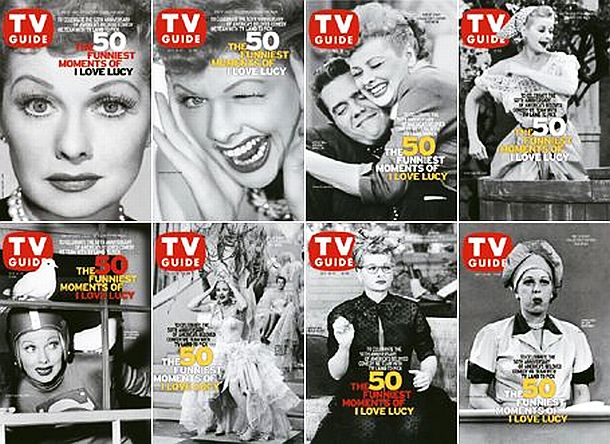
October 2001: As part of the celebration of the 50th Anniversary of the “I Love Lucy” show, TV guide assembled and published a set of eight “I Love Lucy” covers which highlighted some of the “50 funniest moments” from the show.
To mark the golden anniversary of the I Love Lucy show, TV Guide magazine and TV Land cable TV channel teamed up to select “The 50 Funniest Moments” from the I Love Lucy show. Those 50 moments were assembled in a special October 13, 2001 edition issue of TV Guide. For its part, TV Land, the cable channel, telecast an I Love Lucy marathon during October 15th-19th, 2001, showcasing the episodes from which the funniest moments were selected. In addition, TV Guide produced a commemorative set of the eight I Love Lucy covers highlighting those moments as well, plus a special cover exclusive to online visitors. The special set of covers could also be purchased through the TV Guide store.
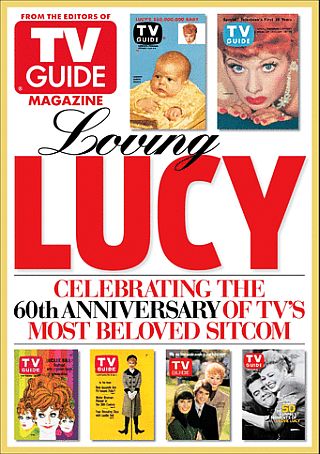
Poster for the 60th Anniversary TV Guide / Paley Center exhibit, “Loving Lucy,” that ran in New York & Los Angeles in late 2011.
TV Guide teamed up with the Paley Center for Media in New York City to salute Lucille Ball in her centennial year with a multi-dimensional exhibit titled “Loving Lucy.” TV Guide’s Jeff Hardy designed the exhibit highlighting some 43 Lucy covers with captions for each, plus additional information from each issue. Some 20 of the covers were featured in blown-up size, with Lucy portrayed by artists such as Richard Amsel, Bob Peak, Ronald Searle, and Philippe Halsman, as well as other leading illustrators and photographers.
The Paley Center contributed exclusive footage for specially designed screenings on Lucy and her life. Together, all the elements of the “Loving Lucy” exhibit took guests through the history of Lucy and Desi’s marriage, the birth of their children, their success with Desilu, and the challenges Lucy faced with balancing career and home life. In New York the exhibit ran from September 28 to November 27, 2011; in Los Angels, from October 8 to November 28, 2011.
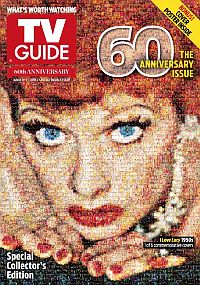
April 2013: One of six commemorative covers TV Guide used for its 60th anniversary was a Lucy rerun from 1957.
Over the years then, for six decades, TV Guide and Lucy had quite a mutually-enriching relationship. Those years marked an historic time for memorable television programming. But the print media proved to be a key ingredient to the success of the electronic media, especially in the early years. TV Guide certainly contributed to both Lucy’s TV celebrity and the success of television generally. But after a time, Lucy the celebrity also helped sell lots of TV Guides – no doubt reason for her many appearances on the cover. In fact, the three interacting ingredients – TV star, print guide, and the TV medium itself – proved something of a winning calculus for all three in terms of TV ratings, magazine sales, and celebrity notice (though some likely saw it as part of the “bread-and-circuses” game). In any case, television today is a much different entity, with a greater array of participants, contributors, competition and choices, with few shows dominating the viewing audience as Lucy once did, and no single TV-show listing source capturing viewer-readers as TV Guide once did.
Readers of this story may also find “CBS Loved Lucy” of interest, which covers the history of the I Love Lucy show and the other Lucy sitcoms, as well as the rise of Desilu Studios along with Lucy and Desi biography. For other story choices at this website please see the thumbnail sketches on the Home Page, or visit the “Print & Publishing” page for stories in that category. Thanks for visiting — and if you like what you find here, please make a donation to help support the research and writing at this website. Thank you. – Jack Doyle
|
Please Support Thank You |
____________________________________
Date Posted: 26 January 2015
Last Update: 9 August 2017
Comments to: jdoyle@pophistorydig.com
Article Citation:
Jack Doyle, “Lucy & TV Guide: 1953-2013,”
PopHistoryDig.com, January 26, 2015.
____________________________________
Sources, Links & Additional Information
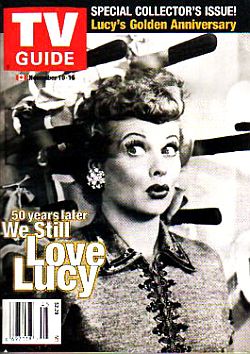
November 2001 Canadian edition of “TV Guide,” special collector’s issue, celebrating “I Love Lucy’s” 50th anniversary.
“The Cover Archive,” TV Guide Magazine.com.
“List of TV Guide Covers (1950s),” Wikipedia.org.
“Lucy the Lecturer,” TV Guide, October 31, 1959.
Dan Jenkins, “A Visit With Lucille Ball,” TV Guide, July 18, 1960.
“The Lucy Show” (Review), TV Guide, 1963.
Dwight Whitney, “The President Wore a Dress To the Stockholders Meeting,” TV Guide, July 15-21, 1967.
Michael Logan, “TV Guide Magazine’s 60th Anniversary: How Desi Arnaz Jr. Became Our First Cover Star,” TVGuide.com, April 3, 2013.
“Taylor-Burton Diamond,” Wikipedia.org.
Michael Karol, Lucy A to Z: The Lucille Ball Encyclopedia, iUniverse, 2004, 451pp.
“TV Guide Magazine, LLC,” Hoover’s Company Profiles, Answers.com.
Ileane Rudolph, “Celebrating 60 Years of I Love Lucy,” TV Guide.com, September 29, 2011.
“TV Guide,” Wikipedia.org.
______________________________